Call us (647) 490-8001
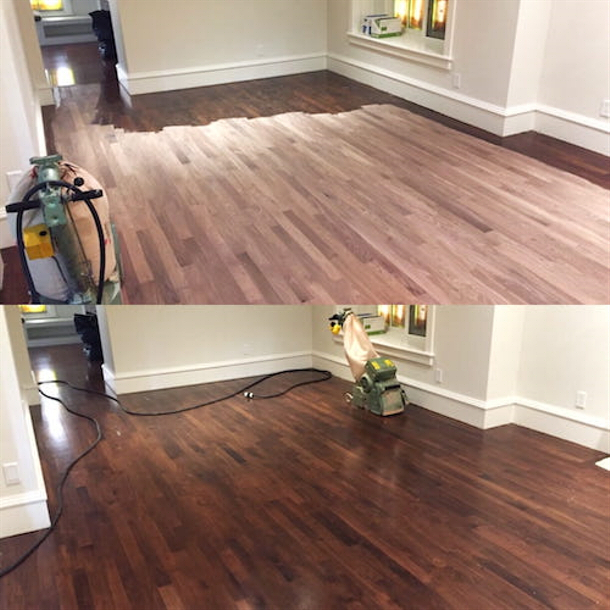
Homepros provides hardwood wood floor refinishing, cleaning, repair, and installation services to Etobicoke and Toronto surrounding GTA areas. We service all aspects of sanding, restoration, wood repairs, deep cleaning methods (when sanding is not necessary), installation, and all modern hardwood floor refinishing in the Etobicoke Toronto areas.
Call us (647) 490-8001
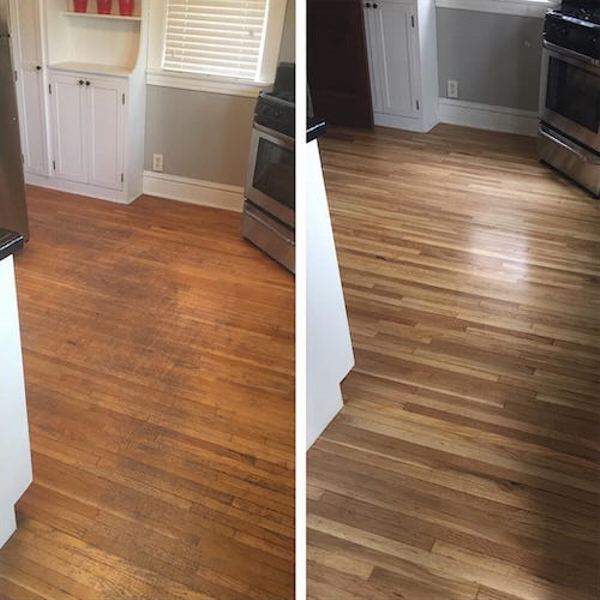
Call us (647) 490-8001
We provide multiple options of refinishing, cleaning, repair, and installation. Our tradesmen our all certified in the craft of applying stains, sealers, water based polyurethanes, light natural finishes, and new eco material on all species of hardwood floors. Do you need to refinish or clean your wood floors because you are moving into a new home or business, the floors are worn, there is damage, you are moving out, or you are looking for a new style? Our detailed consultation process will give you the answers you are looking for.
Want to Revamp Your Old Wood Floors?
Are your floors worn out, scratched, or stained?
Are they discolored due to sun exposure or spills?
Many people want to breathe new life into their homes by fixing their old floors but have no clue what the best option is. They may hesitate between sanding them down & refinishing and simply replacing them with new wood floors or perhaps even laminate flooring (please don’t!).
That’s where our expertise comes in. Over the past 30 years in the wood floor refinishing business, we have restored thousands of different floors. Most wood floors can be completely restored, and you can select any stain, color, and tone to match your home’s updated decor. This is not just a temporary solution; you are getting new floors that will last for the next 15, 20, or even 50 years.
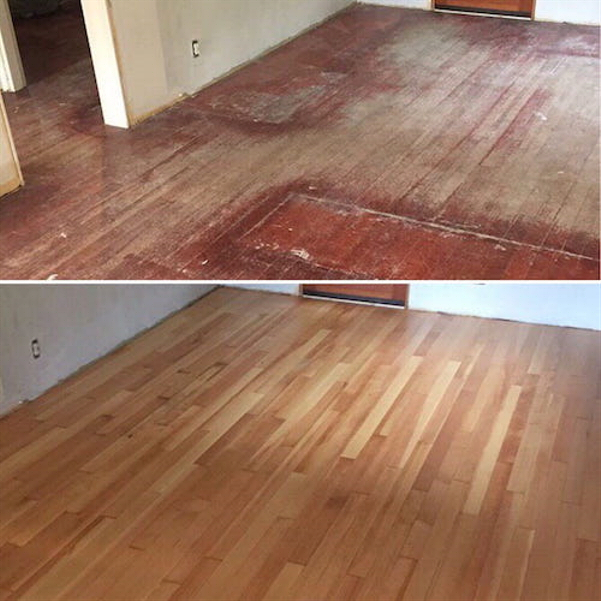
Call us (647) 490-8001
Although we are not the only, we are certainly the #1 Floor Hardwood flooring and Refinishing Contractor in Etobicoke, whose knowledge and skill you can trust to look after your hardwood floors. We specialize in refinishing hardwood floors of all types, which includes sanding, staining, finishing, hardwood repair, hardwood add-ons, & hardwood installation of solid & engineered hardwood. We refinish solid hardwood, parquet, and engineered wood floors & stairs of all types. With customer satisfaction a top priority, we always find the best and most reasonable solution for your particular situation, taking into consideration the condition of your floors, the project timeline, and, of course, your budget.
Sanding & Refinishing Hardwood Floors
Sanding, Staining, & Refinishing Hardwood Floors
Traditional hardwood floor refinishing is our specialty.
Call us (647) 490-8001
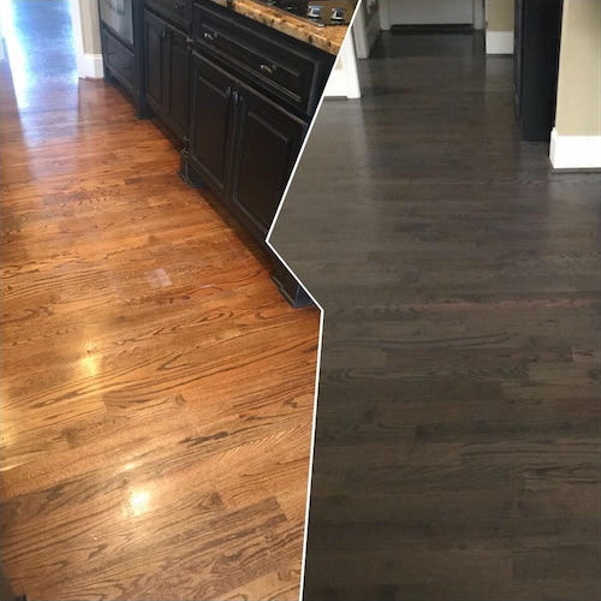
Call us (647) 490-8001
Let us perform an on-site visit to your Etobicoke residence, and we will evaluate the current condition of your old hardwood floors. To the untrained eye, they may all look the same. That’s why you can count on our over three decades of experience to accurately assess your flooring situation, including the species of wood, whether it was pre-finished or finished on site, whether it has a top nail, and the thickness of the top layer, among others. During our visit, we would also like to learn more about your personal preferences. Hardwood floor refinishing gives you a lot of freedom with the choice of color, finish, and overall look of your hardwood floors.
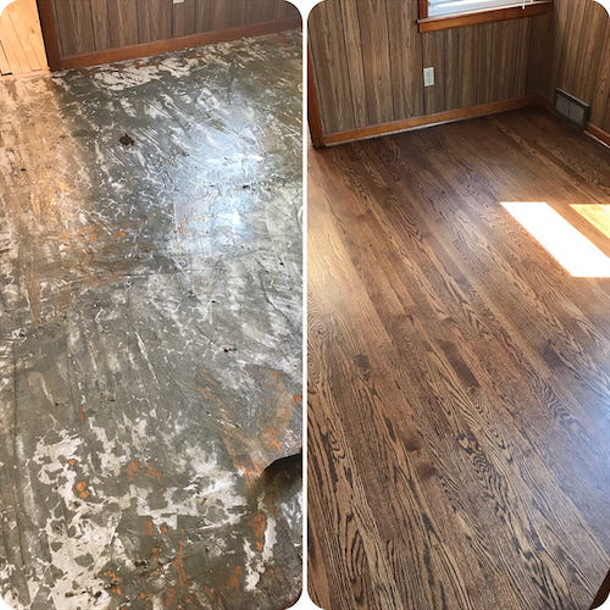
Sandless Floor Refinishing
Sandless Floor Refinishing (same as Recoating and Screening). Are you happy overall with your current hardwood floors, but feel that they just don’t look as bright as they did, and regular mopping doesn’t seem to do the trick? We can definitely help! Sandless hardwood floor refinishing, also known as recoating, is a method of removing the top layer of the dull finish and reapplying a new finish, so your floors get their fresh look back. Moreover, if regularly done, recoating can actually increase your floors durability and longevity, which is good for your wallet!
Complete Hardwood Floor Restoration
Hardwood floor restoration is a custom way to find the best service option/solution to remedy your current flooring issues in the Etobicoke Toronto areas. It might include hardwood floor installation and add-ons or an extension of your existing wood floors (we will carefully match the wood floors’ type, plank size, and species). Repairs can also be made for minor damages, but in case of pet-related stains and deep scratches, water damages, and spot burns, we can replace individual planks and perfectly match them to the original hardwood flooring in terms of species, dimensions, and even natural wood aging. We also do custom staining (to match old floors or match your design requirements) and can do an on-site live stain demonstration, in addition to demonstrating selected or custom stain finishes, so you can see how new floors will match your living space.
Hardwood Floors Refinishing Before & After
These before and after pictures are of real projects. These floors were restored by our expert floor refinishers. We have sanded, repaired, stained, & refinished over 4,000 hardwood floors in the Toronto GTA area and counting. We specialize in bringing sad looking hardwood floors back to life! Not only will they look great again, but we can assess and fix all technical issues, such as gaps, cracks, separations, waves, subfloors squeaks, etc.
Etobicoke is an administrative district and former city within Toronto, Ontario, Canada. Comprising the city's west end, Etobicoke is bordered on the south by Lake Ontario, on the east by the Humber River, on the west by Etobicoke Creek, the cities of Brampton, and Mississauga, the Toronto Pearson International Airport (a small portion of the airport extends into Etobicoke), and on the north by the city of Vaughan at Steeles Avenue West.
The area of Etobicoke was first settled by Europeans in the 1790s. Primarily an agricultural district, it was incorporated in 1850 as Etobicoke Township. The municipality grew into city status in the 20th century after World War II. Several independent villages and towns developed and became part of Etobicoke, first when Metropolitan Toronto was formed in 1954 and later, in a 1967 consolidation. In 1998, its city status and government dissolved after it was amalgamated into present-day Toronto.
Etobicoke has a highly diverse population, which numbered 365,143 in 2016. It is primarily suburban in development and heavily industrialized, resulting in a lower population density than the other districts of Toronto. Much of its cityscape is characterized by larger main streets, shopping malls, and cul-de-sac housing developments. Etobicoke has several expressways, including Highways 427, 401, 409, the Queen Elizabeth Way and Gardiner Expressway. Etobicoke is the western terminus of Line 2 Bloor-Danforth of the Toronto subway and is served by four suburban rail stations of GO Transit. Humber Polytechnic is in Etobicoke, encompassing two campuses, one of which is also home to the University of Guelph-Humber.
Toponymy
The name "Etobicoke" derives from the Mississauga word wah-do-be-kang (wadoopikaang), meaning "place where the alders grow". This was how they described the area between Etobicoke Creek and the Humber River. The first provincial land surveyor, Augustus Jones, also spelled it as "ato-be-coake." Etobicoke was finally adopted as the official name in 1795 at the direction of Lieutenant Governor John Graves Simcoe.
History
At different times throughout history, different groups of First Nations peoples used the land that is now present day Etobicoke. As the Algonquins gradually moved west from the Atlantic to Lake Erie, it is almost certain they would have occupied this land. By the time they were mostly settled on the shores of Georgian Bay, the Huron-Wendat were the primary residents of Lake Ontario's north shore. During the 17th century, the powerful Haudenosaunee (Iroquois) confederacy, made up of nations based to the south of the lake, pushed them out.
After continued harassment from the Iroquois to the south, a coalition of the Ojibway, Odawa, and Potawatomi Algonquin nations, known as the Three Fires, gradually pushed the Haudenosaunee off this land. The Algonquian-speaking Mississaugas settled here by 1695, fishing and growing crops more locally in the summer and hunting farther afield in the winter.
A map depicting the Toronto Purchase in 1787. The inclusion of Etobicoke in the purchase was contested until 2010, when the dispute was settled between the Government of Canada and the Mississaugas.
The British officials intended Etobicoke to be included in the Toronto Purchase of 1787.
However, the Mississauga and government disagreed as to whether the western boundary of the purchase was the Humber River or the Etobicoke River (now, Etobicoke Creek). The Mississauga Indians allowed British surveyor Alexander Aitkin to survey the disputed land, and the British paid an additional 10 shillings for the purchase, although the purchase was never formally agreed to. The dispute was settled between the government and the Mississauga First Nation in 2010.
Immigrants from the British Isles were among the new settlers, as well as Loyalists who had left the rebellious Thirteen Colonies, by then the United States. Early settlers included many of the Queen's Rangers, who Simcoe gave land to help protect the new capital of Upper Canada and develop this frontier area. In 1793-95, the Honourable Samuel Smith, a colonel in the Queen's Rangers, received land grants of 1,530 acres (6.2 km2), extending from today's Kipling Avenue to Etobicoke Creek, and north to Bloor Street.
On March 18, 1797, Sergeant Patrick Mealey received the first land patent for a plot on the west side of Royal York Road on Lake Ontario. This was part of the First Military Tract, or "Militia Lands", which extended from today's Royal York Road to Kipling Avenue, south from Bloor Street. The Crown was providing land to Loyalists in compensation for property they left behind in the U.S. and to veterans of the American Revolution in payment for service. In other parts of Ontario, the Crown granted land to the Iroquoian First Nations who had served as allies during the war and were forced to cede most of their land in New York to the state. The Crown granted more land to members of the Queen's Rangers in the First Military tract, but most did not occupy their land. Many sold their acreage after a short time.
The census of 1805 counted 84 people in the township of Etobicoke. In 1806, William Cooper built a grist mill and saw mill on the Humber river's west bank, just south of Dundas Street. The 1809 census counted 137 residents. The Dundas Street bridge opened in 1816, making the township more accessible.
John Grubb's House, built in 1832. Grubb helped found the community of Thistletown in present-day Etobicoke.
On May 18, 1846, the Albion Road Company was incorporated. Its purpose was to build and maintain a road to the north-west corner of Etobicoke, where a new community was planned. At the same time, John Grubb, who had already founded Thistletown, hired land surveyor John Stoughton Dennis to plan a community at the intersection of Islington Avenue and Albion Road, to be named Saint Andrew's. Plan 6 for this community was registered on October 15, 1847. The French master of Upper Canada College, Jean du Petit Pont de la Haye, contracted land surveyor James McCallum Jr. to create a plan for the community planned by the Albion Road Company, and Plan 28 was registered for Claireville on October 12, 1849.
The township of Etobicoke was incorporated on January 1, 1850. The first meeting of the town council was held on January 21. Present at the meeting were reeve William Gamble, vice-reeve W. B. Wadsworth and aldermen Moses Appleby, Thomas Fisher, and John Geddes. The council convened monthly meetings at a variety of places. In 1850, the township's population was 2904. By 1881, the population of Etobicoke township was 2976.
In 1911, the community of Mimico was incorporated on land taken from Etobicoke township. New Toronto was incorporated on January 1, 1913. Early on, there was talk of merging Mimico and New Toronto. A 1916 referendum on amalgamating the two communities was approved by the residents of Mimico, but rejected by residents of New Toronto. In 1917, Mimico became a town and in 1920, New Toronto became the Town of New Toronto. Long Branch was incorporated in 1930 as a village.
In 1954, Etobicoke Township became a part of the newly formed regional government, the Municipality of Metropolitan Toronto ("Metro"). In 1967, the township of Etobicoke was merged with three small lakeside municipalities — the Village of Long Branch, the Town of New Toronto, and the Town of Mimico — to form the Borough of Etobicoke. The borough was reincorporated as a city in 1984. In 1998, six local municipalities (including Etobicoke) and the Metropolitan Toronto government merged to form the amalgamated city of Toronto.
Character
This section contains promotional content. Please help improve it by removing promotional language and inappropriate external links, and by adding encyclopedic text written from a neutral point of view. (October 2020) (Learn how and when to remove this message)
Humber Bay Park is one of several municipal urban parks in Etobicoke.
Etobicoke has the lowest population density of the former cities and boroughs comprising the city of Toronto. This is mainly due to its expanses of industrial lands along the various expressways.
The residential areas are primarily single-family dwellings, although several large multi-story high-rise condominium developments have been built in south Etobicoke near the Humber River over the past few years. The central and northern areas of Etobicoke have many high-density apartment complexes set in the middle of sizable, open fields and parks. The central/southern areas, such as Markland Wood, The Kingsway, New Toronto, Mimico and Long Branch, have large green spaces, many parks, and main street shopping areas.
Etobicoke has many public parks. Located on the banks of the Humber River, James Gardens, a popular site for wedding photography, features seasonal flowers, walkways, a rock garden, streams, and waterfalls. Etobicoke also has Centennial Park, a large recreational park, and Colonel Samuel Smith Park and Humber Bay Park on the lakeshore. Etobicoke has several golf courses. St. George's Golf and Country Club was ranked in 2007 as one of the three best golf courses in Canada.
Neighbourhoods
New condos in Islington-City Centre West (2021)
Main article: List of neighbourhoods in Etobicoke
Etobicoke is generally divided into three large areas roughly corresponding to its political ridings. Each has neighbourhoods, mostly developments of 19th-century 'postal villages' (rural neighbourhoods), that were built at key points along the early roads and railways; especially the three former 'Lakeshore Municipalities' that separated from Etobicoke in the early 20th century and Etobicoke's central Islington community:
A Neo-Georgian designed home in Mimico. The Lakeshore's neighbourhoods were first to urbanize in Etobicoke.
The Lakeshore (Etobicoke—Lakeshore), along the north shore of Lake Ontario and the "Lake Shore Road" (now Lake Shore Boulevard West), comprises three former municipalities that were the first to urbanize and became separate municipalities during the first half of the 20th century: Mimico, New Toronto and Long Branch, and related communities that were never separate from the Township of Etobicoke; namely, Alderwood (originally a suburb of New Toronto), and Humber Bay (a historic gateway community connecting to Toronto) which was originally sprawl from the east side of the Humber River that was subsequently split by the construction of Ontario's first motor vehicle 'freeway' in 1938, which cuts across the top of southern Etobicoke; (the Queen Elizabeth Way).
Today, the original remnant residential (northern) section of Humber Bay is north of The Queensway, east of Mimico Creek to the Humber River. The commercial, southern section of Humber Bay retains only Christie's Biscuits bakery, as high-rise condominium towers and clustered row housing have forced out virtually all other commercial/industrial employment uses. In the late 1990s, the former McGuiness Whisky factory was converted into a high-rise loft condominium which became the centrepiece of the Mystic Pointe development. Etobicoke's first railway opened through the area in 1855, just north of the Lake Ontario shoreline, leading to the first period of growth as it replaced Dundas Street in Central Etobicoke as the main means of transportation and the industrial centre along its right-of-way.
A residence in Humber Valley Village neighbourhood. Development in the Humber Valley Village began in the early 20th century.
Central Etobicoke (Etobicoke Centre); the oldest communities in Etobicoke developed along the first street, Dundas Street, in the south of this area, which crosses the width of Etobicoke on the escarpment formed by the ancient shoreline of Lake Iroquois. This area centres around the Islington community, the former administrative centre of Etobicoke and later Etobicoke's 'downtown' which is near the central 'Six Points' intersection at its western boundary. The rural Richview community developed directly to the north of Islington in the 19th century on Eglinton Ave. (formerly Richview Rd.), as did the gateway Humber Heights communities (connecting to Toronto): Westmount and Humbervale, to the east on Eglinton. Development of the until-then largely undeveloped eastern part of central Etobicoke (originally a forest reserved for the use of government mills as "The King's Mill Reserve"; "Kingsmill"), the "Humber Valley", was largely the work of Robert Home Smith starting about 1900 and including the communities of The Kingsway and Humber Valley Village. The Kingsway neighbourhood has attracted many affluent individuals and families (as of 2001, over 50% of households have an income in excess of CA$100,000/year).
As Etobicoke developed in the post-war years, low-density residential areas filled in most of the rural areas between the old communities including Thorncrest Village, Princess-Rosethorn and Eringate – Centennial – West Deane as well as the older Eatonville community to the west of Islington. Central Etobicoke includes Etobicoke's most exclusive neighbourhoods, with fine housing stock and many large treed properties. Along the East and West Mall parallel to Highway 427 exists a mix of hi-rise rentals, townhouses and post-war bungalows. Markland Wood is the farthest western community within Etobicoke/Toronto; situated along Bloor Street West, it is predominately single family housing with some mixed hi-rise rentals.
Apartment buildings in Smithfield. Most neighbourhoods in North Etobicoke were built in the years following World War II.
North Etobicoke; The 19th-century Etobicoke communities are Clairville, Highfield, Rexdale, Smithfield, Thistletown which grew along two formerly private roads (now Albion Rd. and Rexdale Blvd.) constructed diagonally across farms in Northern Etobicoke as a shortcut for travellers to Peel County (especially modern Brampton). First developed as an urban area by Rex Heslop in the post-World War II years around the new Rexdale (the Elms) community, northern Etobicoke has many apartment buildings as well as a large 'skyway' industrial park to the west, developed after Malton Airport (in nearby Mississauga) became Toronto's main "Pearson International" Airport.




